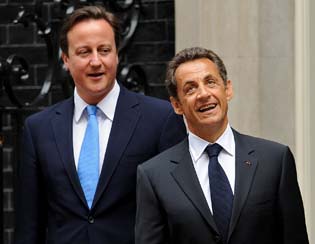“Boots on the Ground”: Sarkozy and Cameron Prepare to Land in Libya
Powerful Naval Strike Group enters Mediterranean

At the end of the G8 summit, the French President Nicolas Sarkozy announced that he would visit Benghazi with the British Prime Minister David Cameron, since “we think alike,” essentially they agree that they “cannot negotiate with Gadhafi.” President Barack Obama expressed the same thought: “We will not relent until the people of Libya are protected, and the shadow of tyranny is lifted.” In other words, they are preparing to occupy Libya.
And while the G8 demands from Tripoli “the immediate cessation of the use of force,” NATO intensifies air raids; in less than eight weeks more than 8,500 have occurred. Most of the planes leave from bases in southern Italy, with supplies coming from others. Pisa is continually crossed over by C-130J and other cargo planes that, from the U.S. Camp Darby base, transport bombs and missiles to bases in the South (foreshadowing what will come into operation when the national air hub opens and begins to transit all troops and materiel to the operational theaters of war.) That the air strikes are preparation for a landing is confirmed by the entry into operation of the French Tiger helicopter, probably accompanied by the British Apache.
Even more significant is the arrival in the Mediterranean of a powerful naval strike group, led by the most modern and powerful Nimitz-class nuclear aircraft carrier, named George H.W. Bush, in honor of the president who in 1991 led in the Persian Gulf the first war in the post-Cold War era (we are now at the fifth). The ship is 333 meters long 40 meters wide and has on board 6,000 personnel, 56 aircraft (which can take off at 20-second intervals) and 15 helicopters, and is equipped with sophisticated electronic warfare systems. It is thus a large mobile military base. At the same time it is a mobile nuclear power plant: It has two pressurized water reactors PWR A4W/A1G, which drive the steam turbine of the four propellers. A nuclear power plant which, despite having on board reactors more dangerous than those in Fukushima, enters the Bay of Naples and other ports.

The Aircraft Carrier George H.W. Bush
The Aircraft Carrier George H.W. Bush is flanked by a battle group consisting of the guided missile destroyers Truxtun and Mitscher, the missile cruiser Gettysburg and Anzio and eight squadrons of aircraft. It’s going to strengthen the Sixth Fleet, whose command is in Naples, alongside other units, including the nuclear submarines Providence, Florida and Scranton. Also added to the Sixth Fleet was one of the most powerful amphibious strike groups, led by the USS Bataan, which alone can land more than 2,000 marines, equipped with helicopters and vertical takeoff planes, artillery and tanks. It is flanked by two other amphibious assault ships, the Mesa Verde and the Whidbey Island, which from May 13-18 visited Taranto in Italy. The Whidbey Island has four huge air cushion landing crafts that, within a radius of 300 miles, can deliver 200 men at a time very quickly to the coast of a country without the ship being visible from land. Everything is ready, then, for a “humanitarian” landing in Libya. The Europeans will have the honor of landing first, under the protective wings of the aircraft carrier Bush.
Our thanks to John Catalinotto who translated this article from Italian

